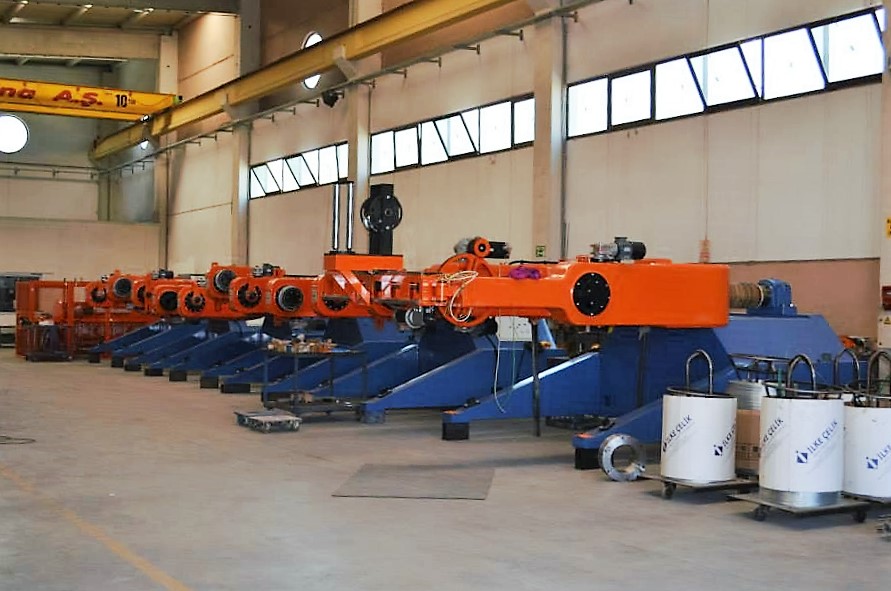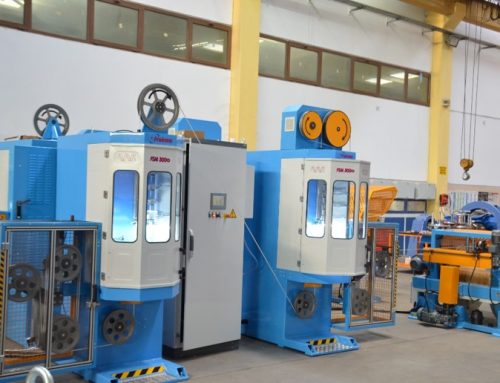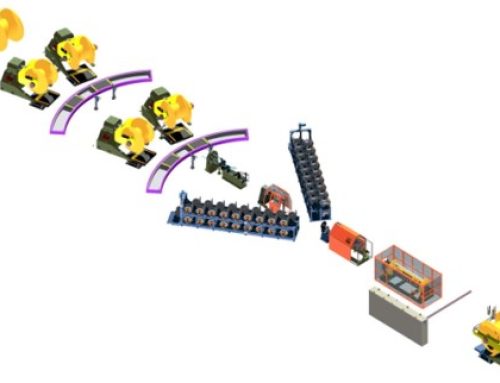Wire Machinery: The Hidden Power of Industry and 5 Groundbreaking Innovations Shaping Its Future. Wire machinery forms the backbone of modern manufacturing, playing a vital role across industries from construction and automotive to medical and electronics. As technology evolves at lightning speed, these machines are becoming smarter, faster, and greener—reshaping the standards of industrial productivity. If you’re aiming to stay ahead of the competition, here are five revolutionary developments redefining the future of wire machinery:
1. The Rise of Intelligent Wire Machinery
- AI-Driven Process Optimization: Next-generation wire machines now integrate Artificial Intelligence to monitor and optimize production in real-time, making intelligent adjustments based on wire properties and operational goals.
- Predictive Maintenance Capabilities: Equipped with advanced sensors and machine learning algorithms, these systems can detect anomalies and predict equipment failures before they occur—minimizing unplanned downtime and reducing maintenance costs.
2. High-Speed, High-Precision Wire Processing
- Advanced Wire Feeding Technologies: Innovative wire feeders ensure smoother, faster wire movement within machines, boosting overall production speed while significantly reducing the risk of wire breakage.
- Laser-Guided Wire Positioning: The integration of laser technology in cutting and welding operations enables ultra-precise processing, allowing for complex designs and tighter tolerances than ever before.
3. Sustainable and Eco-Conscious Engineering
- Energy-Efficient Operation: Modern wire machines are being designed with energy-saving mechanisms that not only reduce environmental impact but also lower operational costs over time.
- Minimized Material Waste: Enhanced processing techniques reduce scrap and leftover wire, supporting greener and more sustainable manufacturing practices.
4. Enhanced Connectivity and Remote Monitoring
- Cloud-Based Monitoring Solutions: Wire machinery is becoming increasingly connected, with cloud platforms enabling remote access, real-time performance tracking, and data-driven decision-making.
- User-Friendly Interfaces: Intuitive touchscreen panels and simplified controls empower operators to work more efficiently with less training and fewer errors.
5. The Future of Wire Machinery: Customization and Flexibility
- Modular Design for Scalable Use: Manufacturers are embracing modular designs, allowing machines to be tailored easily for different wire types, production scales, or industry-specific applications.
- Open Architecture Integration: Open system architecture enables seamless integration with third-party software and tools, further expanding machine capabilities and promoting innovation.
Innovation Is the Key to Staying Ahead
These transformative trends are not just upgrades—they represent a shift in how wire machinery contributes to competitive manufacturing. By staying informed and embracing these innovations, you can future-proof your business, enhance productivity, and unlock new levels of operational efficiency.

You may be interested in this article. The Latest Tech Trends in Cable Manufacturing Equipment
1. The Rise of Intelligent Wire Machines: A Boon for Power Grid Infrastructure
The complex web of power transmission lines that crisscrosses our landscapes is the backbone of modern civilization. These lines, often carrying hundreds of thousands of volts, require robust and meticulously crafted cables to ensure safe and efficient electricity delivery. Traditionally, the machines responsible for producing these power transmission cables have relied on human expertise and experience for optimal performance.
However, the rise of intelligent wire machines is ushering in a new era for power grid infrastructure. By integrating artificial intelligence (AI) and machine learning into the cable production process, these machines are revolutionizing the way high-voltage transmission cables are manufactured.
Here’s how intelligent wire machines are transforming the power transmission cable production landscape:
Unmatched Consistency and Quality: Traditional cable production relies heavily on the operator’s skillset to maintain consistent cable characteristics throughout the manufacturing process. AI-powered wire machines, however, can analyze real-time data on factors like wire temperature, tension, and diameter fluctuations. This allows for automatic adjustments to be made on the fly, ensuring cables meet the stringent quality standards required for high-voltage transmission.
Minimizing Human Error: The high voltages carried by power transmission lines demand cables with zero tolerance for defects. Human error, even the most minor oversight, can compromise cable integrity and potentially lead to catastrophic failures. Intelligent wire machines mitigate this risk by automating critical aspects of the production process, effectively removing human error from the equation.
Predictive Maintenance for Uninterrupted Power Flow: Power outages caused by transmission cable failures can have a significant economic and social impact. Intelligent wire machines can be equipped with advanced sensor technology that collects data on machine health and performance. By analyzing this data, AI algorithms can predict potential equipment failures before they occur, allowing for proactive maintenance and minimizing downtime on cable production lines.
Boosting Overall Production Efficiency: The ability to continuously monitor and optimize the cable production process translates to significant efficiency gains. Intelligent wire machines can identify areas for improvement, such as optimizing wire feeding speeds or minimizing material waste. This data-driven approach allows manufacturers to streamline production, leading to increased cable output and improved cost-effectiveness.
The integration of AI into cable production machines for power transmission lines represents a significant leap forward in ensuring the reliability and efficiency of our power grid infrastructure. As this technology continues to develop, we can expect even more sophisticated intelligent wire machines to emerge, further solidifying the vital role these machines play in delivering safe and reliable electricity to our homes and businesses.
2. High-Speed and High-Precision Wire Handling: The Power Behind Power Delivery
The colossal distances that electricity travels from generation plants to our homes and businesses necessitate power transmission lines with exceptional conductive capabilities. These cables, often bundled together and suspended on towering pylons, are the arteries of our power grid, carrying immense electrical currents with minimal energy loss. At the heart of these cables lies a single, meticulously crafted conductor – a wire that demands both high-speed production and unmatched precision during the manufacturing process.
This is where advancements in high-speed and high-precision wire handling within cable production machines come into play. These machines are equipped with cutting-edge technologies that ensure the conductor is manufactured to exacting tolerances while maintaining impressive production efficiency.
Here’s a closer look at how these advancements are revolutionizing power transmission cable production:
Advanced Wire Feeding Mechanisms: Traditional cable production lines often relied on mechanical capstans or pinch rollers to feed the conductor wire through the various stages of the manufacturing process. These methods, while functional, could introduce inconsistencies in wire tension and potentially damage the conductor. Modern wire machines, however, utilize advanced feeding mechanisms such as servo-controlled drives and dancer arms. These systems provide exceptionally smooth and precise wire travel, minimizing tension fluctuations and ensuring the conductor maintains its integrity throughout production.
Laser-Guided Cutting and Welding for Uncompromising Accuracy: Power transmission cables often incorporate multiple conductor strands woven together to achieve the desired current-carrying capacity. The precise positioning and welding of these strands are crucial for optimal performance. Fortunately, cable production machines are now equipped with laser-guided cutting and welding systems. These systems utilize laser beams to precisely cut conductor wires to the exact length and then weld them together with pinpoint accuracy. This level of precision minimizes conductor material waste and ensures a seamless, high-conductivity connection between the strands.
The Marriage of Speed and Control: The high demand for electricity necessitates the efficient production of power transmission cables. However, raw speed in cable production cannot come at the expense of quality. The latest high-speed and high-precision wire handling technologies address this challenge by striking a perfect balance between speed and control. Advanced feeding mechanisms can handle conductor wires at significantly faster rates while maintaining precise tension. Similarly, laser-guided systems can perform cuts and welds with exceptional speed without compromising accuracy. This translates to a significant increase in cable production output without sacrificing the critical quality standards required for high-voltage transmission lines.
The ability to manufacture power transmission cable conductors with unparalleled speed and precision is a testament to the continuous innovation within the cable production machinery sector. These advancements not only ensure the efficient delivery of electricity but also pave the way for a more robust and reliable power grid infrastructure for the future.
3. Sustainable and Eco-Friendly Innovations: Powering a Greener Grid
As the world strives towards a more sustainable future, the power transmission industry is undergoing a significant transformation. The colossal amount of energy required to transmit electricity across vast distances necessitates a reevaluation of traditional manufacturing practices. Thankfully, cable production machine manufacturers are rising to the challenge by developing innovative solutions that promote eco-friendly cable production for power transmission lines.
Here’s how sustainable and eco-friendly advancements in wire machines are shaping the future of power grids:
Energy-Efficient Manufacturing Processes: The production of power transmission cables can be energy-intensive. Fortunately, manufacturers are developing wire machines equipped with features that minimize energy consumption throughout the cable production process. These features include variable-speed drives on motors, which can significantly reduce energy usage compared to traditional fixed-speed motors. Additionally, the use of energy-efficient lighting systems and optimized heating elements within the machines further contributes to a greener production footprint.
Reduced Material Waste: Every foot of conductor wire wasted during cable production translates to a needless environmental impact. Modern wire machines are being designed with a focus on minimizing material waste. This can be achieved through improved wire handling mechanisms that ensure precise feeding and minimal conductor breakage. Additionally, some machines utilize laser cutting systems with sophisticated nesting algorithms. These algorithms optimize conductor wire layouts, minimizing scrap material and maximizing material utilization.
Embracing Sustainable Materials: The future of power transmission cables lies not just in efficient production but also in the utilization of sustainable materials. While traditional cables often rely on materials like lead or PVC, researchers are exploring the use of bio-based and recyclable materials in cable insulation. While still under development, these advancements hold promise for a future where power transmission cables are not only manufactured sustainably but are also themselves composed of eco-friendly materials.
The integration of sustainable practices into cable production machinery is a crucial step towards a greener power grid. By minimizing energy consumption, reducing material waste, and exploring sustainable materials, the cable production industry is demonstrating its commitment to environmental responsibility. This paves the way for a future where the power delivered through our grids comes not just at a reliable and efficient rate but also with a minimal environmental footprint.
4. Enhanced Connectivity and Remote Monitoring: Keeping an Eye on the Power Pulse
The power grid, the invisible web that delivers electricity to our homes and businesses, is a complex and dynamic system. Ensuring its smooth operation requires constant monitoring and proactive maintenance of its vital components, including the power transmission cables themselves. Traditionally, this involved physical inspections and manual data collection, which could be time-consuming and labor-intensive. However, the integration of enhanced connectivity and remote monitoring capabilities into cable production machines is revolutionizing the way we keep an eye on the power pulse.
Here’s how these advancements are transforming the way we manage power transmission cable production and infrastructure:
Cloud-Based Machine Monitoring: Modern cable production machines are increasingly equipped with sensors that collect real-time data on various aspects of the production process. This data, including parameters like wire tension, temperature, and machine performance metrics, can be transmitted wirelessly to secure cloud platforms. These platforms allow authorized personnel to remotely monitor the health and performance of cable production machines from any location with an internet connection. This not only facilitates proactive maintenance but also allows for real-time adjustments to be made to the production process, further optimizing efficiency and quality control.
Improved Operator Interface and Data Visualization: The days of deciphering complex machine readouts are fading. Modern cable production machines are equipped with user-friendly touchscreens and intuitive interfaces that translate collected data into easily understandable visuals. These interfaces allow operators to quickly identify potential issues, monitor key performance indicators (KPIs), and make informed decisions on the fly. This not only empowers operators but also fosters a data-driven approach to production, leading to improved efficiency and reduced downtime.
Predictive Maintenance for Uninterrupted Power Flow: Power outages caused by cable failures can have a domino effect, disrupting businesses, homes, and even critical infrastructure. Thankfully, the data collected by cable production machines and analyzed through cloud platforms can be used for predictive maintenance purposes. Advanced analytics can identify potential equipment issues before they escalate into major failures. This allows for proactive maintenance scheduling, minimizing downtime and ensuring the uninterrupted flow of electricity through the power grid.
The ability to remotely monitor and manage cable production machines, coupled with improved operator interfaces and data visualization, represents a significant leap forward in the power transmission industry. These advancements allow for a more proactive approach to cable production and grid maintenance, ultimately contributing to a more reliable and resilient power grid for the future.
5. The Future of Wire Machinery: Customization and Flexibility – Powering Diverse Transmission Needs
The world’s energy landscape is undergoing a significant transformation. Renewable energy sources like solar and wind power are playing an increasingly vital role in our energy mix. This diversification necessitates a power grid infrastructure that can adapt to handle a wider range of power transmission needs. Fortunately, the future of wire machinery for power transmission lines is brimming with advancements focused on customization and flexibility. These advancements are ensuring cable production machines can adapt to the evolving demands of the power grid.
Here’s a glimpse into how customizable and flexible wire machines are shaping the future of power transmission cable production:
Modular Design for Adaptability: Traditional cable production machines were often designed for a specific type of power transmission cable. However, the future lies in modularity. Imagine a wire machine where individual modules can be swapped or added depending on the desired cable configuration. This allows manufacturers to produce a wider range of cable types, including those required for integrating renewable energy sources into the grid. For instance, a single modular machine could be used to produce both traditional high-voltage AC (Alternating Current) cables and the specialized DC (Direct Current) cables often used in solar power transmission.
Open Architecture for Seamless Integration: The future of power transmission is likely to involve a complex interplay between traditional and renewable energy sources. This necessitates seamless integration between different components of the grid. Thankfully, the concept of open architecture is gaining traction in the wire machinery industry. Open architecture essentially means that these machines are designed to be compatible with third-party tools and technologies. This allows manufacturers to integrate specialized equipment or software specific to their unique cable production needs, further enhancing the flexibility and adaptability of the machines.
Embracing the Power of Big Data: The vast amount of data collected by modern wire machines holds immense potential for optimizing production and customizing cables for specific applications. Imagine a future where cable production machines utilize machine learning algorithms to analyze real-time data and automatically adjust production parameters based on the desired cable characteristics. This level of data-driven customization would allow for the production of power transmission cables specifically tailored for factors like environmental conditions or integration with renewable energy sources.
The ability to customize and adapt cable production machines to meet the evolving needs of the power grid is a testament to the continuous innovation within the wire machinery industry. By embracing modular design, open architecture, and the power of big data, these advancements are paving the way for a more robust and versatile power grid infrastructure, one that can seamlessly integrate diverse energy sources and deliver electricity reliably and efficiently for generations to come.
In conclusion
the advancements shaping the future of wire machinery for power transmission lines are nothing short of revolutionary. From the intelligent optimization of AI-powered machines to the laser-guided precision of high-speed wire handling, these innovations are transforming every facet of cable production. Furthermore, the focus on sustainable practices, enhanced connectivity, and customizable machine design demonstrates a commitment to not only efficiency but also environmental responsibility and adaptability within the power grid infrastructure.
As the world embraces a more diverse energy landscape, these intelligent, sustainable, and adaptable wire machines stand poised to play a pivotal role in building a robust and reliable power grid for the future. The future of power transmission is bright, and the advancements in wire machinery are undeniably a driving force behind this illumination.



